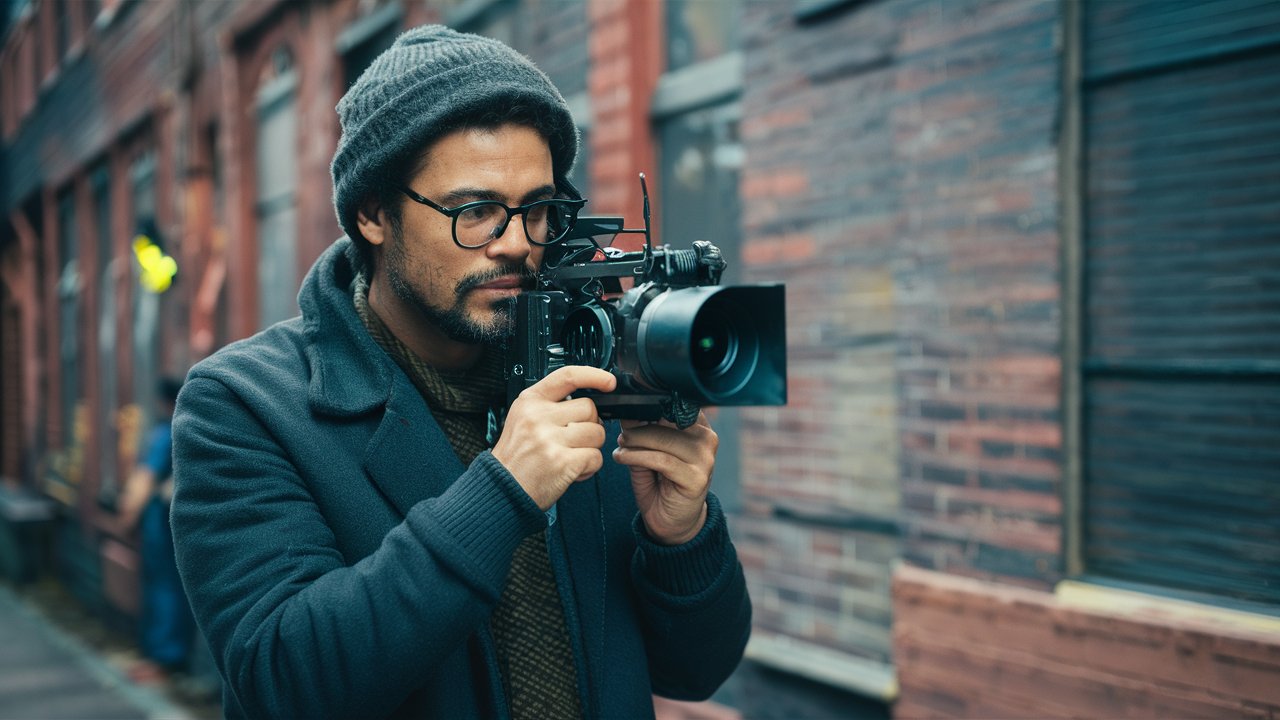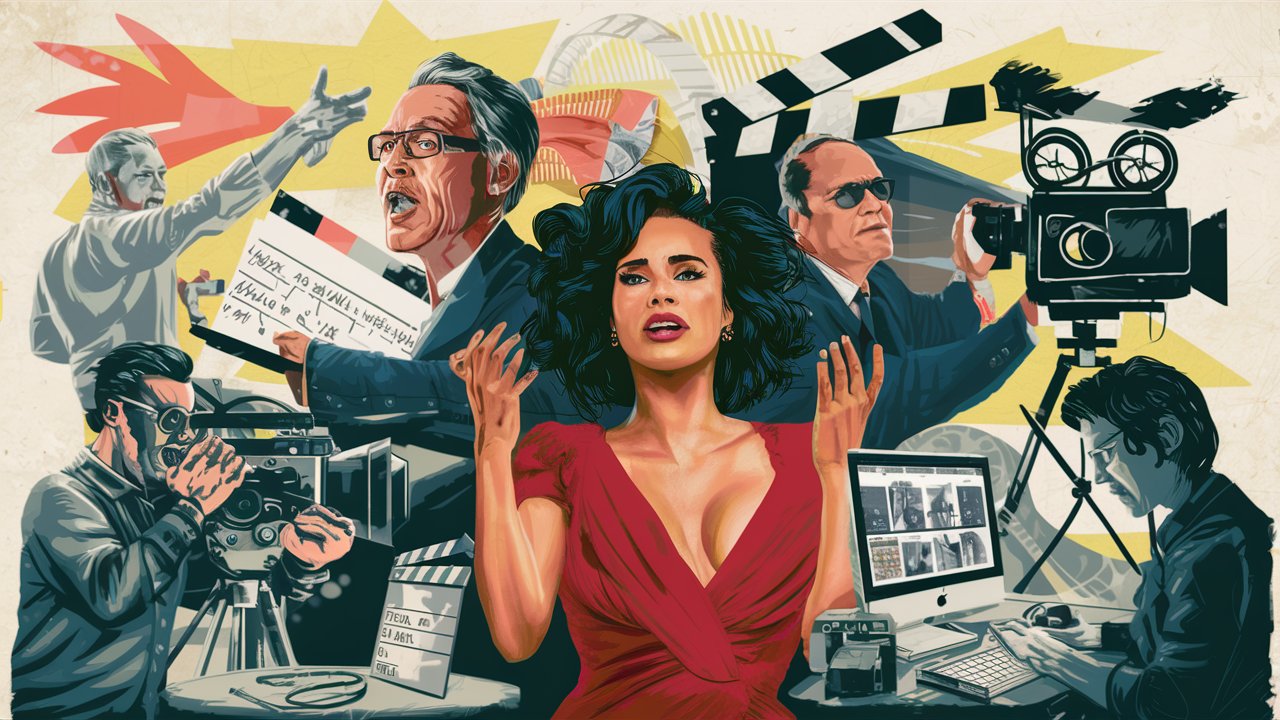In the pulsating heart of cinematic artistry resides a tapestry woven not with mere threads, but with light and sound, words and silence—a galaxy of boundless creativity awaiting its maestros. “Unveiling the Secrets: The Essential Elements of Filmmaking” beckons you to traverse the enigmatic landscapes of visual storytelling, screenwriting sorcery, directorial symphonies, audial enchantments, editing alchemy, cinematographic hues, and post-production wizardry.
Here lies a treasure trove brimming with insight for aspiring auteurs seeking to wield the tools that sculpt dreams into frames flickering across silver screens.
For those who yearn to speak in the mesmerizing tongue of cinema—where every shot whispers stories only those with keen eyes can decipher—and for connoisseurs perched on velvet seats craving enlightenment beyond what meets the eye; this expedition carves pathways through the mysterious realms that birth moviemaking magic.

Embark upon this journey armed not with swords or shields but with pen and lens, music notes dancing in your mindscape like fireflies on a serene night—an odyssey where wisdom unfurls as reels spin and shadows pirouette under ethereal spotlights. Let us together illuminate these darkened corridors of creation; for understanding is the key that unlocks doors leading to realms where celluloid dreams dance in luminous splendor.
Through the Lens: Decoding Visual Narratives in Filmmaking.
Imagine a canvas painted not with oils or watercolors, but with shadows and light, moving images that tell tales without uttering a single word. Welcome to the realm of visual storytelling in filmmaking, where every frame is a brushstroke on the grand tapestry of cinema.
Camera angles dance like silent partners, whispering secrets through their intimate embrace with actors; lighting and composition are the artists’ palette, setting moods that linger long after the screen fades to black.
In this symphony of sight and sound, visual storytelling reigns as maestro. Consider Hitchcock’s masterpiece “Vertigo,” where the spiraling staircase becomes a metaphor for obsession and descent into psychological depths. Each step echoes Scottie’s inner turmoil, teasing viewers with unspoken fears and desires.
Or perhaps delve into Tarantino’s “Pulp Fiction,” where non-linear storytelling intertwines character arcs like a complex puzzle waiting to be decoded – a visual feast served on a cinematic platter.

From sweeping establishing shots that frame narratives within landscapes to tight close-ups that delve into characters’ souls, camera angles wield power beyond mere recording devices; they are storytellers themselves.
Lighting plays its part too – casting shadows that whisper intrigue or flood scenes with warmth like basking in afternoon sunbeams. Think of “Blade Runner” with its eerily lit alleys painting cyberpunk dystopias or “Amélie” using vibrant colors to mirror whimsical moments of joy in its Parisian tale.
Visual storytelling isn’t just about what the eye sees; it’s about what the heart feels and the mind understands. In Wong Kar-wai’s “In The Mood for Love,” long takes stretch moments into eternity, mirroring characters’ longing gazes across crowded rooms.
It’s in these nuanced details – an actor’s subtle glance or a play of light on water – that stories breathe life beyond dialogue. So next time you watch a film, look past words spoken; let visuals speak volumes in their silent eloquence.
The Power of Screenwriting.
In the symphony of filmmaking, the script stands as the heart where characters spring to life and dialogues dance off the pages. Imagine a canvas waiting to be painted with vibrant personalities and compelling narratives.
The screenplay isn’t just words written on paper; it’s a blueprint for emotions that will grip audiences and take them on a rollercoaster ride of laughter, tears, or suspense. Great screenwriting is akin to crafting intricate tapestries of storytelling filled with nuanced characters who breathe fire into scenes with every line they utter.
Developing strong characters isn’t merely about giving them names and occupations; it’s about understanding their deepest fears, desires, and motivations that drive the story forward. Each character should resonate with authenticity, like old friends we recognize even in new faces.

For example, consider the iconic character arcs in ‘Forrest Gump,’ where Forrest’s simplicity belies layers of depth that make his journey through history so profoundly moving and relatable. Characters become the essence of storytelling, their actions revealing more than their words ever could.
Engaging dialogue acts as a melody that lingers in viewers’ minds long after the credits roll—a dance between conflict and resolution, woven with wit or gravity depending on the tale being spun. In well-crafted scripts like ‘Pulp Fiction‘ or ‘The Social Network,’ dialogues aren’t just exchanges between characters; they are revelations, conflicts bubbling under the surface ready to erupt at any moment, painting tension in broad strokes across each scene.
A solid script can turn ordinary words into verbal sword fights or tender confessions that sear themselves into our memory long past the final scene—showcasing how screenwriting is truly where stories find their soul.
Mastering Film Directing Techniques.
In the enchanting realm of filmmaking, directors stand as maestros orchestrating a symphony of visuals, emotions, and narratives. Their canvas is the silver screen, their brushes the actors who breathe life into characters carefully crafted by the woven tapestry of screenwriting.
Akin to conductors guiding an intricate musical piece, film directors bear the weighty responsibility of steering every aspect of production toward a coherent vision. Through visionary leadership and creative acumen, they transform mere scripts into captivating tales that enrapture audiences worldwide.
One cannot underestimate the pivotal role that directors play in extracting authentic performances from actors. Like sculptors molding clay into timeless artistry, directors sculpt raw talent to carve unforgettable portrayals on celluloid.

From meticulously detailing character motivations to fostering an environment conducive to creativity and spontaneity on set, these guiding hands shape performances that resonate with viewers on profound emotional levels. Think of renowned directors like Martin Scorsese coaxing out raw intensity from Robert De Niro in “Taxi Driver,” creating cinematic magic through their symbiotic collaboration.
Exploring the tapestry of film direction reveals a kaleidoscope of styles and approaches as diverse as the storytellers themselves. Each director bears a unique artistic fingerprint manifested in their visual aesthetics, thematic preferences, and narrative signatures.
From Tim Burton’s whimsical gothic fantasies to Quentin Tarantino’s non-linear storytelling peppered with pop culture references, every director’s oeuvre serves as a cinematic fingerprint—a hallmark distinguishing their works amidst the vast landscape of cinema.
By delving into these case studies of luminaries in filmmaking, aspiring filmmakers glean insights into how creative decisions mold narratives and leave indelible imprints on audiences’ hearts long after the credits roll.

In this dance between vision and execution lies the essence of film directing—a delicate balance between boundless imagination and pragmatic realization. Aspiring filmmakers embarking on this exhilarating journey must heed not only technical prowess but also harness the power of inspiration and storytelling alchemy woven within them.
To master film directing techniques is to embrace a voyage marked by challenges yet illuminated by boundless creativity—an odyssey where each frame captured mirrors not just an image but a glimpse into the soulful depths of the human experience itself.
In the intricate dance of filmmaking, one often underestimated maestro quietly conducts the symphony of emotions – sound. Picture yourself submerged in a world where every rustle, sigh, or crescendo carries the weight of storytelling.
The artistry of sound design and music in the film not only sets the stage but weaves an invisible thread that binds characters to their essence and narratives to our hearts. From murmurs that breathe life into a scene to thundering scores that herald epic battles, the sound is the pulse that echoes deep within cinematic experiences.

Sound editing isn’t just about adjusting volume levels; it’s sculpting raw noise into a masterpiece. It’s the meticulous snipping and stitching that birth silences pregnant with anticipation or explosions ripe with intensity. Imagine how mixing orchestrates a delicate balance between dialogue, effects, and music – each note synchronized to stir emotion effortlessly within viewers.
Then there’s scoring; melodies haunting in their beauty or adrenaline-pumping compositions that elevate action sequences to heart-racing heights.
Step back and reminisce about those iconic movie moments where sound became a character in itself. Recall the relentless ticking of a clock adding urgency in “Dunkirk,” or John Williams’ unforgettable theme soaring as Luke Skywalker gazes at twin suns.
These instances aren’t just auditory embellishments but pillars supporting entire emotional landscapes meticulously constructed through sonic artistry. In films like “Jaws” or “Psycho,” it wasn’t what you saw but what you heard that set pulses racing and spines tingling – proving that sometimes, true cinema magic lies hidden within realms untouched by light but resonant with sound.
The Art of Editing: Sculpting Stories with Precision.
In the mesmerizing dance of filmmaking, editing steps forth as the architect of narrative coherence and emotional resonance. An uncut gemstone of a film is transformed into a shining masterpiece through the meticulous hands of an editor.
This craft is where the raw emotions captured on camera are refined, polished, and strung together to create a seamless flow that ensnares hearts and minds alike. Just as a sculptor chisels away at the time marble to reveal a statue’s true form, editors carve away excess footage to unveil the essence of a story.

The power of editing lies not only in what is shown but also in what is left unseen. Continuity editing stitches scenes together seamlessly, guiding the viewer through the passage of time effortlessly. Montages weave disparate moments into emotional tapestries that tug at heartstrings, while jump cuts startle and disrupt, imbuing narratives with tension or disorientation.
Consider iconic examples like the shower scene in Hitchcock’s “Psycho,” where rapid cuts intensify fear to near-paralyzing levels, or the parallel editing in “The Godfather,” juxtaposing events for maximum impact.
Editing doesn’t just trim scenes; it orchestrates symphonies of sight and sound, directing attention like light through a prism. The rhythm, pace, and emotional beats of a film are often dictated by this invisible hand behind the scenes.
Imagine walking a tightrope between evoking empathy through lingering close-ups or building suspense with quick cuts that leave viewers breathless. In essence, editing isn’t about deleting footage—it’s about revealing truth, heightening drama, and crafting an unforgettable experience that lingers long after the final credits roll.
Cinematography: Painting with Light.
In the realm of filmmaking, cinematography stands as a maestro orchestrating visuals, painting with light and shadow to weave intricate tales of emotion and spectacle. The artistry behind cinematography is akin to a delicate dance between hues and contrasts, guiding the viewer’s gaze through a kaleidoscope of moods and atmospheres.
Through color schemes that whisper melancholy blues or scream fiery reds, framing techniques that trap characters in solitude or freedom, and camera movements that swoop like eagles or tiptoe-like whispers, cinematographers craft visual poetry that speaks to our souls.
Different genres bear distinct cinematic styles as varied as the galaxies in the universe. From the stark chiaroscuro of film noir casting shadows over morally ambiguous characters to the vibrant palettes of musicals bursting into song and dance, each genre employs cinematography as a storytelling tool.

In the mystique-filled world of fantasy, colors dance harmoniously to transport us to realms beyond reality; in gritty crime dramas, shadows, and high-contrast lighting mirror moral ambivalence and societal decay with unrelenting precision. Each frame is not just a snapshot but a carefully curated canvas where every brushstroke influences how we interpret the narrative.
Comparing cinematographic styles becomes an exercise in dissecting visual languages—deciphering why a horror movie thrives on low-key lighting while a romantic comedy basks in soft pastels. Behind every scene lies a deliberate choice by cinematographers who merge technical mastery with artistic intuition.
Just as painters infuse life onto canvases using brushes dipped in color, so do these magicians of light breathe vitality into each frame they capture—their lens capturing not just images but emotions distilled into visual symphonies that resonate long after the screen fades to black.
Post-production Magic: VFX & CGI.
In the mesmerizing tapestry of modern filmmaking, post-production magic weaves a spellbinding narrative where reality and imagination dance in harmony. Visual effects (VFX) and computer-generated imagery (CGI) stand as the enchantresses of this realm, sculpting worlds where the ordinary transforms into the extraordinary with the mere click of a mouse.
These digital sorcerers create realms beyond our wildest dreams or meticulously craft scenes that blur the lines between what is tangible and what is born from pure creativity. Through VFX and CGI, filmmakers harness the power to breathe life into dragons soaring across vast skies or construct alien landscapes that beckon viewers into uncharted territories.

Remember how in “Avatar,” James Cameron conjured the luminous bioluminescent jungles of Pandora, entwining viewers in an otherworldly embrace that transcended traditional storytelling? Such creations are not merely pixels on a screen but gateways into realms where fantasy meets reality in seamless fusion.
From the edifice-strewn landscapes of “Inception” to the roaring dinosaurs of “Jurassic Park,” filmmakers utilize VFX and CGI as their paintbrushes, crafting masterpieces that resonate deep within our souls. These tools are not mere embellishments but architects of emotions—heightening tension, evoking awe, or unraveling mysteries previously confined to imagination alone.
It is within these vibrant realms that stories leap off screens with vivid intensity, blurring boundaries between what is possible and what lies within the boundless confines of human ingenuity.
Unveiling the Tapestry: Crafting Cinematic MasterpiecesIn the intricate tapestry of filmmaking, each thread represents a crucial element that, when woven together skillfully, creates vibrant cinematic experiences. Visual storytelling sets the stage, screenwriting breathes life into characters and dialogue, while directorial finesse acts as the guiding hand shaping raw performances into memorable moments.
Soundscapes and editing add symphonic rhythm and pacing to narratives, cinematography paints with mesmerizing light, and post-production magic sprinkles films with visual wonders. Like a maestro conducting an orchestra, a filmmaker harmonizes these elements to evoke emotions, challenge perceptions, and immortalize stories on screen.

As we unravel the secrets behind the curtain of filmmaking’s essential elements, aspiring filmmakers stand at an exciting crossroads where creativity meets technique. Embrace these tools not as standalone entities but as interconnected pieces of a grand puzzle waiting to be solved with innovation and artistry.
Experiment boldly with the canvas of visual storytelling, sculpt compelling characters through powerful scripts, navigate the directorial maze seeking authenticity, orchestrate soundscapes that resonate in hearts, wield editing tools to craft seamless narratives, dance with light through cinematography’s lens, and explore boundless realms through VFX wizardry. Let your imagination soar beyond boundaries; for in this realm of moving pictures lies your voice yearning to narrate tales yet untold.

I am a highly experienced film and media person who has a great deal to offer to like-minded individuals. Currently working on several exciting projects, I am a film and media practitioner for over a decade. I have achieved a great deal of success in my professional career.


9 Responses
Thank you for your sharing. I am worried that I lack creative ideas. It is your article that makes me full of hope. Thank you. But, I have a question, can you help me?
Your article helped me a lot, is there any more related content? Thanks!
Your article helped me a lot, is there any more related content? Thanks!
Thank you for your sharing. I am worried that I lack creative ideas. It is your article that makes me full of hope. Thank you. But, I have a question, can you help me?
Can you be more specific about the content of your article? After reading it, I still have some doubts. Hope you can help me.
Thank you for your sharing. I am worried that I lack creative ideas. It is your article that makes me full of hope. Thank you. But, I have a question, can you help me?
Thanks for sharing. I read many of your blog posts, cool, your blog is very good.
I don’t think the title of your article matches the content lol. Just kidding, mainly because I had some doubts after reading the article.
Your article helped me a lot, is there any more related content? Thanks!